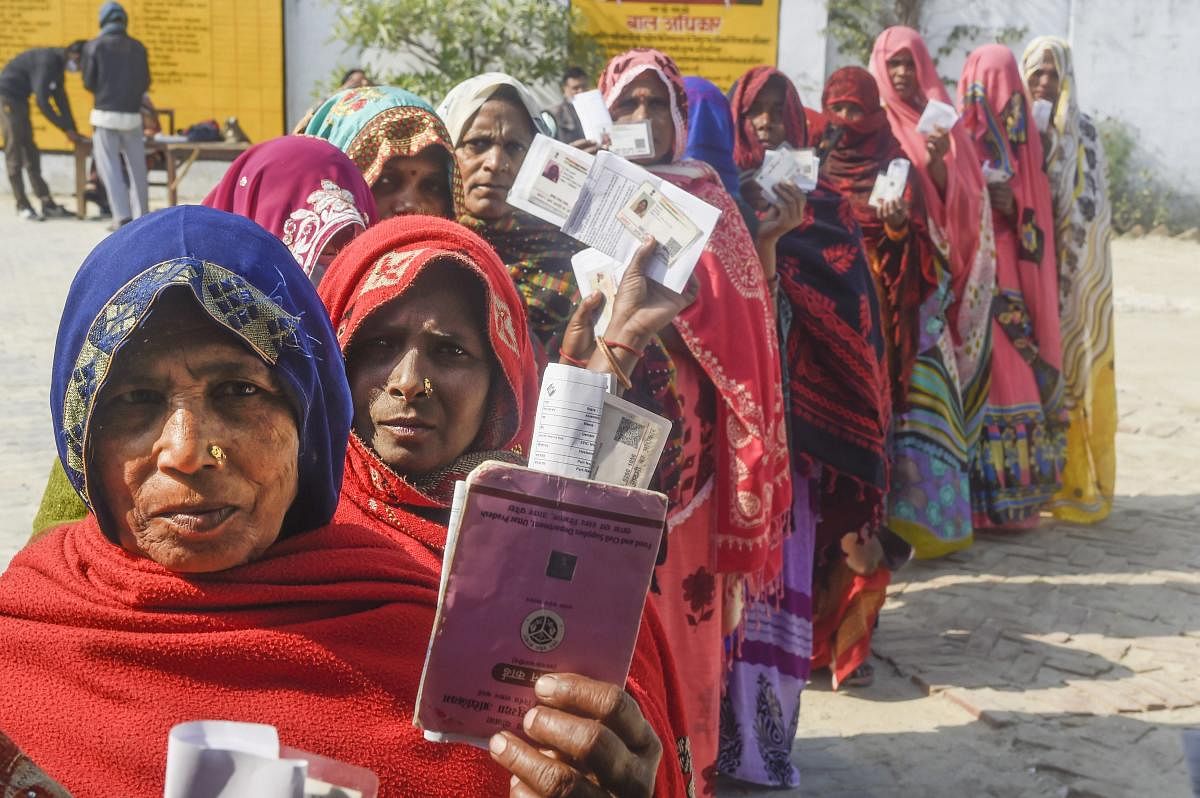For a decade now, women in India’s largest state are its biggest vote bank, outnumbering men at the polling booth – a phenomenon that has baffled many a political analyst.
With 20.5 crore people, UP is as big as a dozen European Union nations combined, by population. By developmental parameters, the state is no trailblazer. Unlike its counterparts in the South, UP does not fare well in female literacy or sex ratio. At 63.4%, the state’s female literacy lags the nationwide average of 70.3%. At 903, UP’s sex ratio, too, is way lower than the national average of 933.
So, this phenomenon of more women voting – in a state where 47% of voters are women, as against 53% men -- piques interest. In 2012, and then in 2017 and then again in 2019, women voters have landed up at the polling booths more than male voters.
Political commentator and journalist Arati Jerath, who has long reported on political parties and their upheavals, says that one of the first instances of women showing an active interest in politics in large numbers in the hinterland was during LK Advani’s Rath Yatra in the early 1990s. She recollects women following the rath, picking up bits of the earth and putting it on their head. Since then, Jerath says, women’s interest in politics has only gone up.
In the 2012 Assembly elections, the first time when more women turned up to vote than men in UP, 60.28% of women voters voted while 58.68% of male voters did. Similarly, in 2017, 59.15% of male voters voted and 63.31% of women voters cast their votes. This time, there are more women voters who have newly registered to vote -- 28.86 lakh women to 23.42 lakh men.
Despite a decade of voting in larger numbers than men, it is only now -- in 2022 -- that political parties seem to have finally woken up to the possibilities of the women voter. Manifestoes, surveys and sops have been carefully crafted to woo the women voters.
Promises of gas cylinders, laptops, rations and financial grants, and focussed attempts at reaching out to women are some of the steps that parties are taking.
The BJP has tailored Kamal Saheli Clubs across the state to tell women voters of all the schemes that the government has offered them and will do so in the future. The Ujjwala scheme, rations for women as well as the housing scheme Pradhan Mantri Awas Yojana, have helped buoy BJP’s chances. In December, when the BJP was starting its UP campaign, PM Modi addressed two lakh women’s self-help group (SHG) workers.
The Congress, on the other hand, with a visible Priyanka Gandhi leading the charge, reserved 40% of tickets for women. The party has promised mobile phones, electric scooters, 40% reservation for women in government jobs, and 25% in police jobs. The party does not have a solid network of cadres in UP anymore, but it has fielded some unlikely women – the mother of the Unnao rape victim, an anti-CAA/NRC activist, amongst others.
The SP-RLD combine has played up the lack of safety of women under the BJP regime and has promised jobs to women if it comes to power.
For a state with such a large representation of women voters, political representation remains low. UP’s 403-member Assembly has only 42 women MLAs. Of the 370 candidates it has fielded, the BJP has given tickets to 42 women. Four more tickets for women have come from its alliance partners, Apna Dal (Sonelal) (3) and Nishad Party (1). The Congress has fielded 161 women.
Which leads us to ask: For a state that has had two women Chief Ministers, how will the women vote in UP?
There might not be absolute numbers, and only after voting day will a clearer picture emerge. But there is a clear indication that more and more women are deciding whom to vote for themselves, as opposed to voting for someone their family has decided. This is far more visible in states considered backward. In the Bihar elections in 2020, a huge chunk of voters of CM Nitish Kumar were women. In the Assembly elections in Bengal in 2021, a solid 50% of women voters carried Mamata Banerjee to her third-term victory.
Surveys by the Centre for the Study of Developing Societies (CSDS) have indicated that women’s political choices during elections have changed in the last few years. In the 2009 Lok Sabha elections, 43% of women voted without taking anyone’s advice. This rose to 81% by 2019.
Sanjaya Kumar of the CSDS says that unlike Bihar and West Bengal, in UP, women have not been the specific factor behind any win. The women’s vote in UP tends to come in handy in pushing a tilt further, he says.
Abbin Theepura, of the political consultancy firm Politique Marquer (P-Marq), says that more and more women are voting independently. They do not listen to men alone, discussions among themselves in platforms like SHG groups for exchange of ideas is a reality. This is a trend that can be seen in both rural and urban areas, he says.
In most backward states, where husbands leave their homes to find work in other parts of the country, women are increasingly getting comfortable with the idea of decision-making. So, the demand from parties stems from personal needs. Women are increasingly looking at what are the benefits they will derive from voting for a particular party.
There is a growing realisation that they have to make themselves visible in polling booths, so that parties will give them what they want. This consciousness, Jerath says, is more acute in backward states where women bear the brunt. They can make their presence felt only when an election comes.
